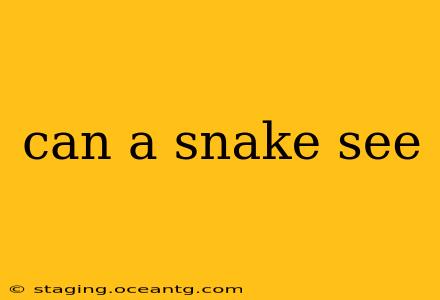Can a Snake See? Unraveling the Mysteries of Snake Vision
Snakes, those often misunderstood reptiles, possess a fascinating visual system adapted to their unique lifestyles. While not all snakes see equally well, the common misconception of them being nearly blind is far from accurate. The truth is much more nuanced and depends heavily on the species and its environment.
What kind of vision do snakes have?
Snakes have varying visual acuity depending on their lifestyle and habitat. Diurnal snakes (active during the day) generally have better vision than nocturnal snakes (active at night). Their eyes lack eyelids, instead possessing transparent scales that protect them. These scales are shed along with the rest of the snake's skin during molting.
Many snakes possess binocular vision, meaning they can see with both eyes simultaneously, allowing for some degree of depth perception. However, the extent of this depth perception varies widely among species. Some snakes, particularly those that are ambush predators, rely more on their sense of smell and infrared detection than on their eyesight.
How well do snakes see compared to humans?
Compared to humans, snake vision is generally less acute. They don't see colors as vividly as we do and their visual acuity is lower, meaning they can't see fine details as well. Think of it like having a lower resolution image. While they might see movement and shapes clearly at close range, distant objects might appear blurry or indistinct. The degree of this difference varies greatly based on the snake species.
Do snakes see in color?
Some snakes can see color, although their color vision is likely not as rich or diverse as that of humans or primates. Many diurnal species possess some degree of color vision, which aids in prey detection and mate recognition. Nocturnal snakes, however, tend to have poorer color vision, relying more on other senses. The exact range of colors they perceive is still an area of ongoing research.
Do all snakes have the same vision?
No, not all snakes have the same vision. As previously mentioned, vision varies greatly among species. For example, snakes that live in open environments and rely on sight for hunting, like some colubrids, tend to have better vision than snakes that live in burrows or dense vegetation and rely more on other senses. This diversity in visual capabilities reflects the adaptive pressures of their respective habitats and hunting strategies.
How does a snake's vision work with its other senses?
A snake's vision is just one component of its sophisticated sensory system. Many snakes integrate their visual input with other senses like smell (using their Jacobson's organ), infrared detection (pit vipers), and vibration detection to create a comprehensive understanding of their environment. This multi-sensory approach allows them to successfully hunt and navigate their surroundings. The way these senses interact is specific to each species.
Can snakes see in the dark?
The ability of snakes to see in the dark depends largely on the species. Nocturnal snakes have adaptations that help them see in low-light conditions, though their vision is not as sharp as in bright light. They may possess larger pupils or more sensitive retinal cells to capture available light. Some snakes, particularly pit vipers, can detect infrared radiation, allowing them to "see" the heat signatures of their prey even in complete darkness. However, this infrared "vision" isn't exactly like seeing light; it's detecting heat.
In conclusion, while not all snakes possess the same visual capabilities, to say they can't see at all is a vast oversimplification. Their vision is adapted to their specific lifestyles and environments, effectively contributing to their survival and success as predators. Further research continues to reveal the intricacies of snake vision, adding to our understanding of these fascinating creatures.
